Yves Saint Laurent & Piet Mondrian
No art and fashion collaboration list would be complete without the classic and iconic Yves Saint Laurent dress inspired by artist Piet Mondrian. Saint Laurent released the 1965 dress for the Autumn season; its simple A-line, and tidy shift silhouette was typical of the mid-sixties. What was perhaps less typical was the clear allusion Saint Laurent was making to Mondrian in his uses of graphic black lines (running both horizontally and vertically) and white and primary color blocks. Its seamlessness is deceiving—the dress is made up of many of individual pieces of wool jersey and was hand-assembled to hide obvious seaming. This dress is not only an icon for Western fashion but also records the importance of Mondrian’s work during the period of the 1960s.
.
Yves Saint Laurent & Andy Warhol
Yves Saint Laurent and Andy Warhol (two men who need no introduction) collaborated in 1974, Saint Laurent is the subject, and the product is a silkscreen image of a youthful Yves by Warhol himself. The work is done in a style similar to Warhol’s other works-an even square divided into four equal quadrants. The portraits are paired diagonally, but the paired images are painted in decidedly different and fanciful ways. The painting stands today as a commemorative gesture to the great fashion designer. Although the painting itself is not a garment or accessory per se, the object stands a reflection of the intimate ties between the culture of fashion and art.
.
Comme Des Garçons & Cindy Sherman
This 1994 collaboration with internationally acclaimed photographer, Cindy Sherman, and Rei Kawakubo, still holds an edge over a lot of the more recent fashion photography campaigns. Sherman is best known for her self-portrait series Untitled Film Stills that feature a number of typified feminine characters. Sherman, inspired by Kawakubo’s already pointedly unconventional fashion sense is driven to create a campaign equally unique. The coquettish personalities of her Film Stills are replaced by the slumped, unhappy and imperfect female persona. These photographs confront the consumer with a model that isn’t particularly ideal at all; she floats in isolated contemplation, caught forever pensive in the frame of Sherman’s photograph. Cindy Sherman would go on to a number of other fashion-related collaborations moving forward with names like Marc Jacobs and Balenciaga.
.
Comme Des Garçons & Merce Cunningham
Rei Kawakubo first started designing under the name Comme des Garçons in 1969, and since then she has been making her name known as one of the foremost avant-garde fashion designers in the world. Merce Cunningham was making himself known under similar terms, but within the dance context. Kawakubo had always “shared similar creative philosophies with Merce Cunningham, including interests in engaging multiple artistic disciplines and aggressively pushing the boundaries of the unknown.” After Cunningham’s initial offer to give her complete freedom in designing the costumes and the set, Kawakubo declined. As myth has it, while working on her notorious spring collection of 1997, titled “Body Meets Dress, Dress Meets Body,” she changed her mind. The collection was an aggressive response to her feelings of boredom with fashion. She padded the dresses in a way to reshape the body under new circumstances—her own circumstances. Similarly to the “Body Meets Dress” collection, the costumes Kawakubo designed for her collaborative work with Cunningham (tilted Scenario) featured the same “irregular bulges on the dancers’ hips, shoulders, chests, and backs.” Wearing these costumes altered the dancers’ proportions, their balance, sense of space, and even their fundamental extent of movement.
.
Marc Jacobs & Juergen Teller
It all began in 1998, and many of us can’t even remember what Marc Jacobs (the brand) looked like before Juergen Teller. Teller’s overexposed and slightly rosy tint make his photographs feel more like adventurous polaroids between friends than esoteric fashion photography. His imagery is playful but always with a little tinge of deflation, grunge or raunchiness—like Jacobs’ clothing. Since the auspicious beginnings of the Teller-Jacobs collaboration in 1998, Marc Jacobs’ ads have become a celebrity fashion yearbook with notable subjects like Winona Ryder, Sofia Coppola, Helen Bonham Carter, Dakota Fanning and photographer Cindy Sherman.
.
Alexander McQueen & Björk
This epic relationship began when Icelandic native Björk released her fourth record, Homogenic in 1997 – and the image that held the album cover got nearly as much press as the music. The “elfin chanteuse” her fans had come to love had transformed into a different almost unrecognizable creature; a creature that, today we know was borne from her collaborative conversations with then, 26-year old Alexander McQueen. “When I went to Alexander McQueen, I explained to him the person who wrote these songs—someone who was put into an impossible situation, so impossible that she had to become a warrior…a warrior who had to fight not with weapons but with love.” The respective work of these two creative geniuses seemed to discuss similar themes of man, nature and machine. The two went on to collaborate several times: McQueen directed Björk’s video for “Alarm Call,” and in 2003, the pair reunited for a Fashion Rocks! performance, where she sported a McQueen gown and crystal mask for the finale of her performance. McQueen was also responsible for Björk’s fantastical bell-covered dress worn in the 2004 video “Who Is It?” And in a 2003 conversation between Björk and McQueen with Index magazine, he said of his own designs that sound like it could have come from either virtuoso, “my work is always in some way directed by nature. It needs to connect with the earth. Things that are processed and reprocessed lose their substance.”
.
Marni & Rop van Mierlo
Italian-based brand, Marni, continues its playful collaborations with artist and illustrators from around the globe. Perhaps one of the most successful choices has been with Dutch artist, Rop van Mierlo. Mierlo, based out of Amsterdam, is best known for his children’s book Wild Animals, which won the Best Dutch Design Award in 2011. The book features pages of blotchy, watery-diffused animals: a snake, a rabbit, a lion, a pig, and a squirrel to name a few. He describes his process as interested in “creating animals he could not control”—how romantic. Though the entirety of Mierlo’s aqueous menagerie is not featured in Marni’s collection—released in mid-January of 2013—his donkey, parrot, ostrich and tiger don the tops, purses, and scarves of many of the most popular looks. In a recent interview with SSENSE Mierlo was asked, “Your animals seem soft, gentle and sweet. In the world of the wild animals you paint, would a tiger ever eat a pig? Would a dog ever bite an ear?” In response he said, “I sure hope so. Otherwise the pig bites the tiger in the rear.”
.
Louis Vuitton & Takashi Murakami
Amidst the millions of anime eyes and smiling flowers of Tokyo-born pop-artist Takashi Murakami’s 2007 exhibition “Superflat,” was the world’s most indulgent museum shop. Monographs, posters, and key chains were reserved for MOCA’sactual in-house store, a Louis Vuitton pop-up establishment with thousand-dollar totes. The monogrammed merchandise featured familiar characters and motifs of Murakami’s and was specially designed for the in-situ boutique. The gesture was an unprecedented one for any American art museum, and in an interview at the opening of the exhibition, supermodel Linda Evangelista was asked by a reporter, “What do you think of this synergy of art and fashion?” Her response, “Well, it certainly makes fashion more interesting.” The collaboration that began in 2003 as multicolored L’s and V’s had evolved into so much more.
.
Louis Vuitton & Yayoi Kusama
2012 was a good year for Japanese artist Yayoi Kusama. She is best known for her use of polka dots, and a retrospective exhibition of her artwork was shown at two major international museums over the course of one year. If you don’t recognize her name, you may have seen the dotted flower sculpture of Beverly Hills or theYellow Trees that enveloped the Whitney Museum development in the Meatpacking District of Manhattan. Kusama told Women’s Wear Daily, “Marc Jacobs came to see me in Tokyo in 2006, and he asked me if I wanted to come to the States and do fashion. That sort of encouraged me because…Fashion has always attracted me.” From this 2006 encounter, blossomed a series of garments, window fronts and shop designs that—thanks to Jacobs’ collaboration—made Kusama’s artistic visions come alive across the globe. Unfortunately, the clothes paled in comparison to the graphic and hypnotic storefronts. Most notable was London’s Selfridge department store that featured Kusama’s favored giant pumpkins—and subsequently, a completely sold out collection. Printemps in Paris donned mirrored window fronts with polka dotted mannequins and silver baubles reminiscent of Kusama’s 1966 Narcissus Garden work.
.
Raf Simons & Sterling Ruby
Belgian fashion designer, Raf Simons, invited German-born, Los Angeles-based artist, Sterling Ruby, in 2008 to use his “Tokyo boutique as a canvas.” Sterling’s intervention transformed the store’s interior from a clinical white space into something that in some ways is hard to describe. The walls were left white by Ruby, and in his typical style, appears to have haphazardly thrown paint everywhere and ended up with something beautiful, simultaneously minimal, and chaotically expressive. The plinths used to display the clothing are black with bleach splashed across them (a technique favored by Ruby in his textile manipulation work), which creates a seductive and unifying tension between the architecture holding the clothes, and the greater structure holding the entirety of the shop. Simons brought on Ruby to create a unique capsule collection following the same aesthetic theme of Tokyo boutique installation the following year. Simons and Ruby have continued their collaborative relationship as recently as 2012, when Simons created fabric with images of four of Ruby’s recent works. The textiles debuted as a part of Simon’s premiere haute couture collection with design house Christian Dior.
.
.
Info: http://www.complex.com/style/2013/04/the-50-best-artist-collaborations-in-fashion/

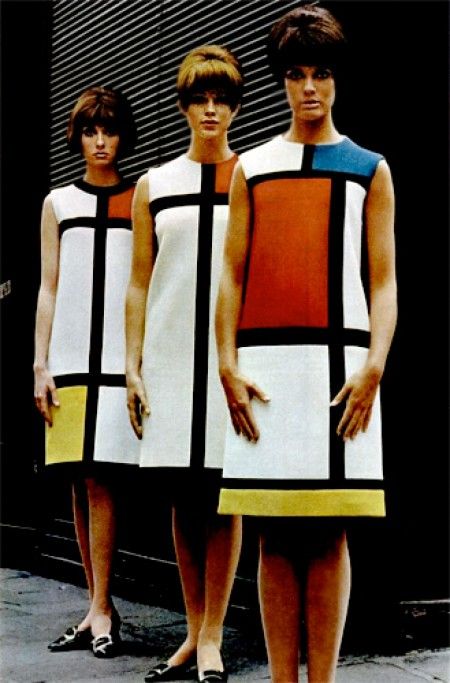



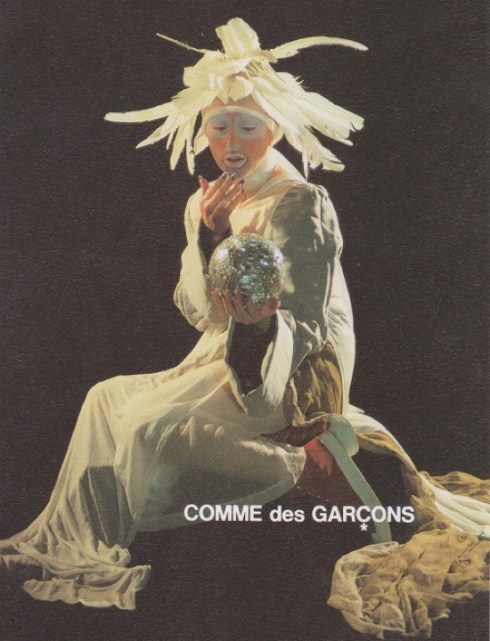
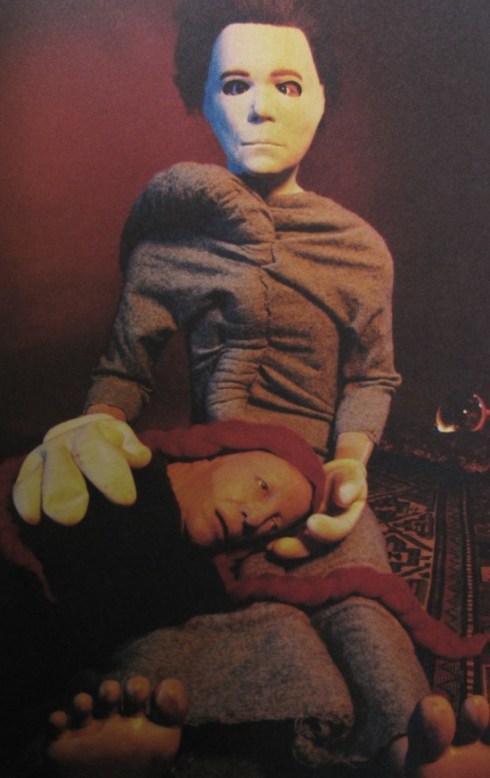


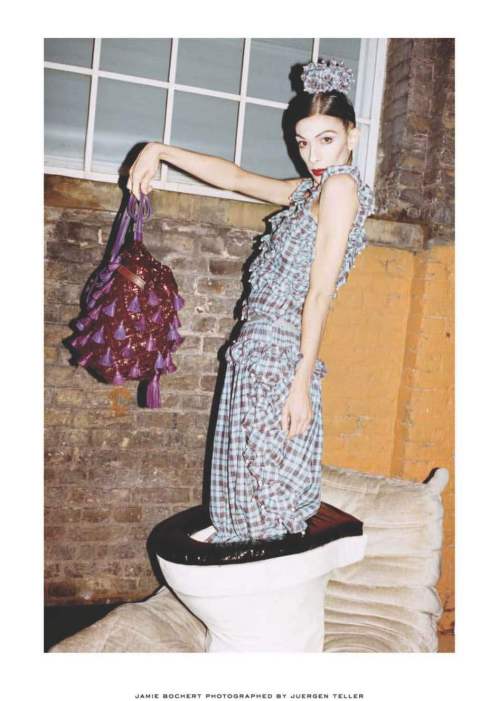

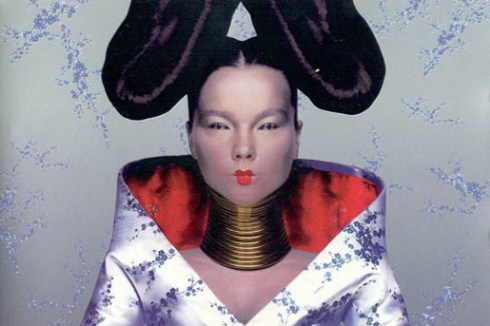





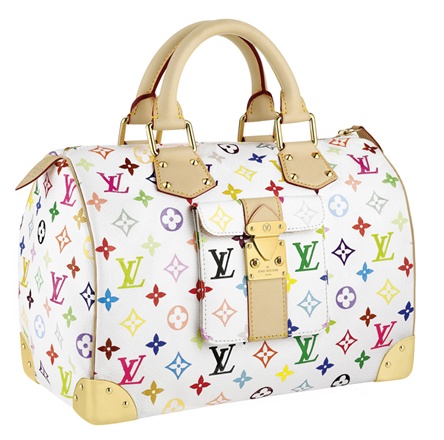


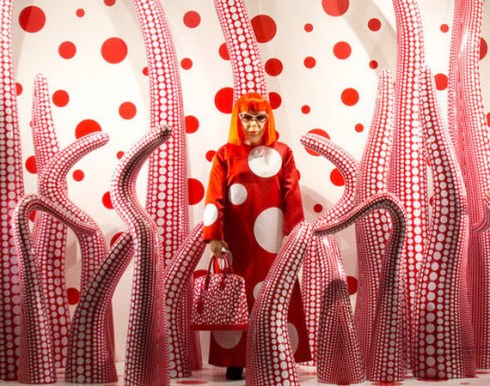
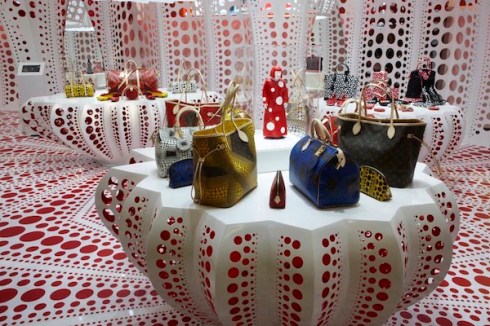
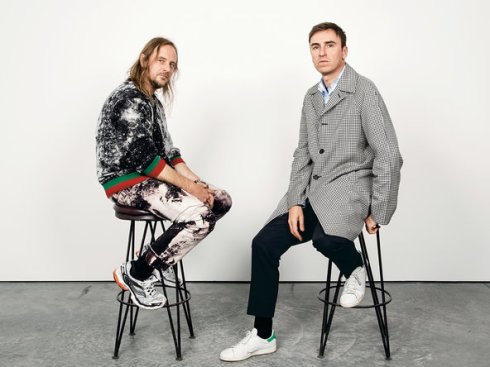
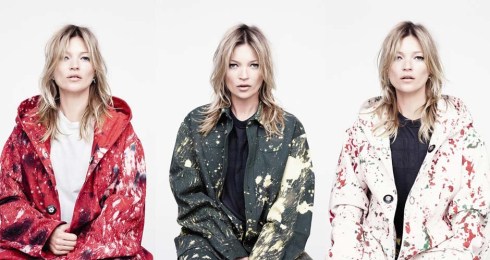
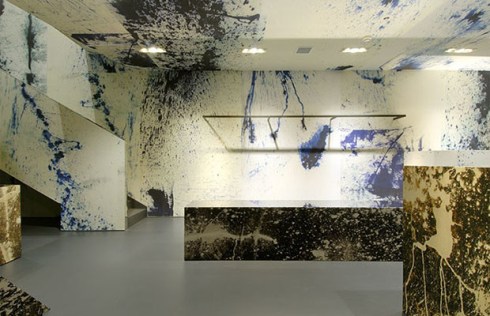
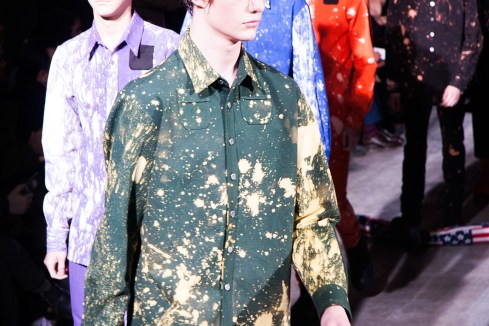



Lovely!!